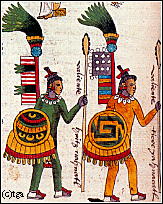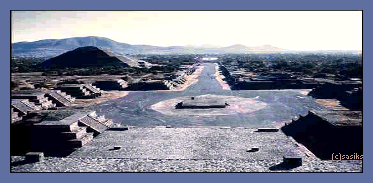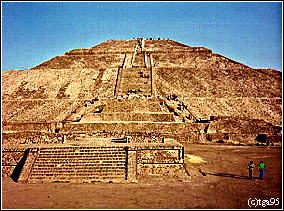Centuries ago, The Aztecs arrived in the Valley of Mexico.
These new settlers named the site Teotihuacan,
which meant "place where the gods were born!". The Aztecs
believed that it was here that the gods created the universe. They settled around 100 BC and it reached its zenith at about four centuries later. It was one of the largest cities in the world at the time of its decline, with possibly as many as 200,000 people. Then it was set on fire and destroyed around 750 AD, and over the years was completely buried.
 from: CODEX MENDOZA; Oxford, Bodleian Library
Aztec soldiers of high military rank.
from: CODEX MENDOZA; Oxford, Bodleian Library
Aztec soldiers of high military rank.
Nothing is known of the original architects of Teotihuacan. The names which the city and its individual buildings are known by are either derived from Nahuatl or, are of recent origin.
For the civilizations which followed, such as the Toltecs and the Aztecs, the abandoned city was a ghost-town of mythical origin.
 On the upper-left side is the
Pyramid of the Sun along Calzada de los Muertos
(Avenue of the Dead)
On the upper-left side is the
Pyramid of the Sun along Calzada de los Muertos
(Avenue of the Dead)
Around the 1st century AD, the lords of TEOTIHUACAN erected
what was to be the largest pyramidal structure for more than a
millenium (the Pyramide del Sol or the Pyramid of the Sun); it was placed directly over a cave that was probably
sacred to TLALOC (the rain god). Its careful alignment
and its four sides proclaim the division of the cosmos into four
cardinal directions, with the vertical axis in the center
probably crowned by a temple, for which the pyramid served as a
base.

The Pyramid of the Sun in honor of HUITZILOPOCHTLI
(god of the sun), is the largest along the mile long
Avenue of the Dead. The base area (220 x 225/722 x 738ft) is almost as big as the Egyptian Pyramid of Cheops. Its height (63m/207ft, with the former temple 74m/243ft) is however less by 70m/230ft, but commands a spectacular view of the entire area. The capacity of its interior, which for the most part is filled with adobe bricks, has been estimated as being a million cubic meters (1,308,000cu.yds.). The most popular speculation as to the purpose of this cave system extends: from a place of sacrifice or a tomb to a cult chamber dedicated to the rain or maize gods.
|


